#si prefixes
Text
Microfiction: A story told in no more than one thousand words.
Nanofiction: A story told in no more than one hundred words.
Picofiction: A story told in no more than ten words.
Femtofiction: A story told in no more than one word.
Attofiction: A story told in no more than one letter.
Zeptofiction: A story told in no more than one punctuation mark or diacritic.
Yoctofiction: A story told by gesturing helplessly toward one's keyboard.
5K notes
·
View notes
Text
just learned that in 2022 four new SI prefixes were defined. shook
3 notes
·
View notes
Text
0373
Microbiome, nanobiome, or picobiome (…or kilobiome?)
5 notes
·
View notes
Text
When I graduated with a degree in physics, the biggest and smallest SI prefices were ‘yocto’ and ‘yotta’. Now, because the total amount of information available to humans is growing so quickly, we've had to expand upwards to ‘ronna’ and ‘quetta’. It's only the physicists love of symmetry that has given us ‘ronto’ and ‘quecto’.
I have 47 yoctobytes of Star Trek :D .
#Système International#SI units#SI prefixes#you may not like my plural of ‘prefix’#but i don't care 😛#always a linguist at heart
1 note
·
View note
Text
Table 2.3 lists the most common prefixes.

"Chemistry" 2e - Blackman, A., Bottle, S., Schmid, S., Mocerino, M., Wille, U.
#book quotes#chemistry#nonfiction#textbook#si units#systeme international#prefix#tera#giga#mega#kilo#deci#centi#milli#micro#nano#pico#femto
1 note
·
View note
Text
Remember when 10^27 was unofficially called "hella" in California, for ages?
Last year, SI passed a resolution to officially define the following prefixes:
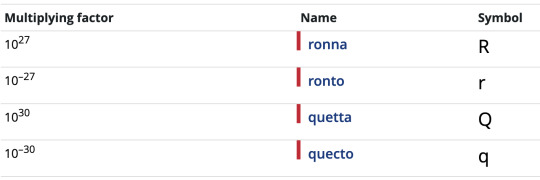
What's particularly funny is that they specifically mention that this is done considering "the importance of timely action to prevent unofficial prefix names being de facto adopted in other communities".
Source / Licence
0 notes
Text
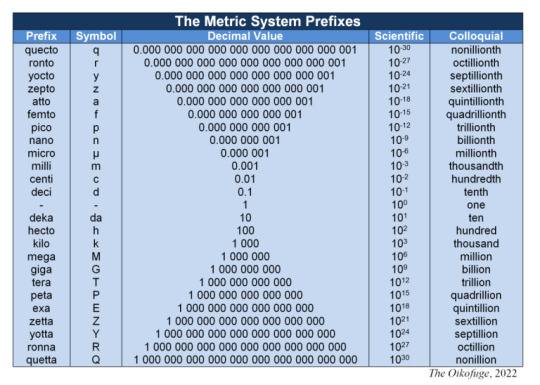
SI Prefixes
In addition to the units and derived units defined by the SI system of units, there are official SI prefixes used to increase or decrease the value of said unit, each multiplying by a value of ten to the power of a whole number. The first three prefixes from unity, in either direction, multiply by ten to the power of plus or minus one, two, or three, but from there the powers increase values of plus or minus three. As of this writing in early 2024 the highest and lowest prefixes respectively are 10 to the power of 30 and -30.
To distinguish between the positive and negative power prefixes, all of the positive power prefixes except the first three (deka, hecto, and kilo - for historic reasons) have capital letters as their symbols. The negative power prefixes use lowercase. Prefixes are added to units to form new words - hyphens and spaces are not used. Similarly, symbols for the prefixes are added directly to symbols for units. For example: a femtosecond, symbolized as fs; or a terabyte as TB.
Eight prefixes closest to unity were first adopted in 1795, two of which (myria and myrio) later fell out of use. These were officially recognized by the governing body in 1889. In 1960, myria and myrio were declared obsolete and the next three prefixes were added in either direction (mega, giga, and tera; and micro, nano, and pico). In 1964, the prefix chart was unbalanced with the addition of femto and atto among the negative powers, rectified in 1975 with the addition of peta and exa. Four prefixes were added again in 1991, with the final four only added in 2022.
Sources/Further Reading: (List from governing body) (Image source) (Wikipedia) (NIST) (Pronunciation and etymologies) (2022 article) (SI Brochure from governing body)
89 notes
·
View notes
Text
Disclaimer: not a native Thai speaker, still learning 🙏
...also, not an expert on tarot and astrology btw djsdhsj
Fortune favors the bold


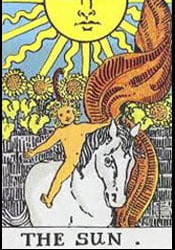

- XXI The World (-> Earth/Ongsa) = accomplishment, seizing opportunities the universe presents, confidence in one's place in the world
- XIX The Sun (-> Sun) = joy, positivity, enlightenment, light illuminating the truth
- X Wheel of Fortune = destiny, soulmates, change, growth, the wheel turning in one's favor

ก็เหมือนกับโลกที่มันต้องมีแสงสว่างจากพระอาทิตย์ไง /gaaw meuuan gap lohk thee man dtawng mee saaeng sa waang jaak phra aa thit ngai/
-> โลก /lohk/ = Earth, the world
-> แสงสว่าง /saaeng sa waang/ = (bright/brilliant) light
And that's what she's been doing all episode 🥺♥ Sun's brightness and warmth give her confidence!



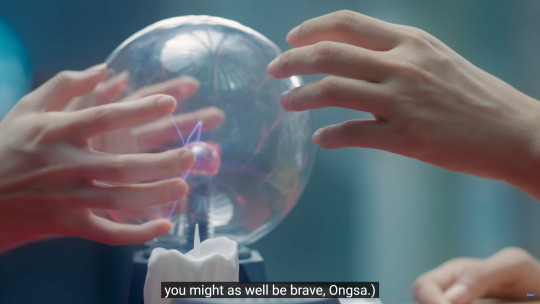

ชอบสิ /chaawp si/
AAAAAAAAHHHHH this can be read as both 'They/That person does like you' and 'I do like you'
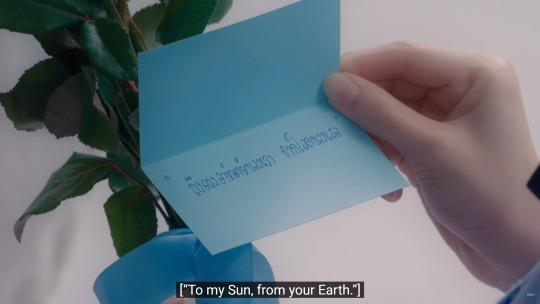
ถึงดวงอาทิตย์ของเรา จากโลกของเธอ /theung duaang aa thit khaawng rao, jaak lohk khaawng ter/
Sun's horoscope

How is Sun a Gemini, you may ask? It's me, I asked, so I went and researched it for everyone lol
In astrology, there's two ways to divide the ecliptic into the 12 signs - tropical and sidereal.

(source)
Western astrology generally follows the tropical zodiac which is based on the Northern hemisphere's seasonal cycle, lining up the equinoxes and solstices with the ecliptic.
Vedic/Hindu astrology follows the sidereal zodiac which is based on the observable sky and thus accounts for the Earth's axial precession and the seemingly backwards movement of fixed stars over time, caused by the Earth's axial tilt of ✨ 23.5 degrees ✨
All of this to say- Sun is a Gemini in sidereal astrology!
First contact
Aylin's coming out of her shell!! I loved her this episode, trying to make friends, expressing herself more and being genuinely funny.


มนุษย์พี่นี่โคตรไร้สาระ /ma noot phi nee khoht rai saa ra/
เมื่อกี้น้องว่าไงนะ /meuua gee nong waa ngai na/
-> ไร้สาระ /rai saa ra/ = nonsensical, lacking meaning/substance, which got subbed as "That's bull." earlier in the same scene??, combined with โคตร /khoht/ here, which is an impolite colloquial intensifier, sounds like "You're full of crap, senior human." lmao


1) ฉันกับยัยเจริญพรจะคอยช่วยแกแล้วกัน /chan gap yai Charoenporn ja khaawy chuuay gae laaeo gan/
2) เจริญพร /ja reern phaawn/ = Yes.
2) Charoen's full first name is เจริญพร /ja reern phaawn/:
เจริญ /ja reern/ = to prosper, prosperous, to pray/chant;
พร /phaawn/ = blessing, benediction
เจริญพร /ja reern phaawn/ is a word used by Buddhist monks for 'yes'/assent/response, just like ครับ /khrap/ or ค่ะ /kha/ are used, for example. There's a whole set of vocabulary/register that's specifically used by and with monks and in the context of Buddhism.
1) Tin calls Charoen ยัยเจริญพร /yai Charoenporn/ several times this episode lmao - ยัย /yai/ stems from ยาย /yaai/ = grandma, and can be used in a friendly way to call a woman or derogatorily (kinda like 'hag', I guess?) It's all in the context but that can be said about a lot of things in Thai language djsdhsjh
It's comparable to colloquial ไอ้ /ai/, a prefix for mostly male names, e.g. ไอ้ติณห์ Ai'Tin, to call someone in a friendly or- cursing way:

ไอ้มนุษย์บุลลี่ /ai ma noot bully/
Obligatory 1st person pronoun moments because there's only the two three*, she doesn't use any otherwise:

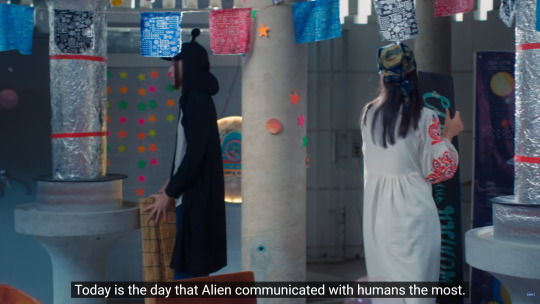

1) เรา /rao/, 2) calls herself alien again, 3) ข้า /khaa/, which sounds old timey
*edited to add her fortune teller shtick
Quick translation of the preview texts
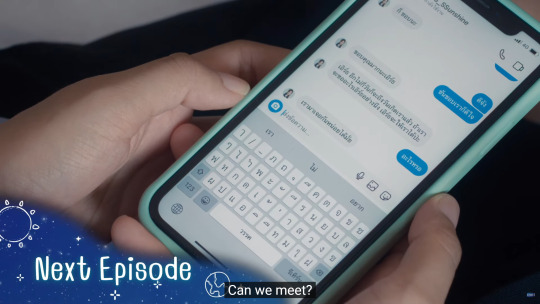
Well... I like [the roses?]
That's nice
You liking [?] makes me happy
Thank you so much, Earth
Earth, it'll be my birthday in a few days. If I asked you for one thing, would you give it to me?
What is it?
Can we meet?
#23.5 degrees#23.5 spoilers#thai gl#ongsasun#aylinluna#milklove#viewjune#milk pansa#love pattranite#view benyapa#june wanwimol#ford arun#earn preeyaphat#local woman harps on about linguistics#i've lost sight of this post's flow with how many times i rearranged and added stuff so if this reads as incoherent- welp.
52 notes
·
View notes
Note
are there words for marsh, bat and snake yet?
For bats, there's a whole bunch in the lexicon! Clan cats consider them Songbirds, with their sensitive hearing naturally picking up the sonorous melodies that our human ears cannot. They are never taken as prey.
Here's a really big intro to "Birds" in Clanmew, a cultural classification that includes bats
For Snakes, there are three types of "snakes" they encounter, one of which is cladistically NOT a snake but they do not know what science is. Snakes are part of a larger classification that includes worms.
Worm (Generic) = Pusa
A long animal without legs, which typically moves through slithering and does not "pupate" into another form. Includes earthworms, leeches, intestinal parasites, and lampreys.
Serpent (Generic) = Sis
Includes adders, grass snakes, and slowworms. A long, "scaled" worm.
Adder (Vipera berus) = Sipya
From Serpent + Slab. The man, the myth, the legend, the ONLY venomous snake that they encounter! Known for their sunning behavior, adders are typically seen in the rockiest parts of ThunderClan and WindClan, but rarely in other territories. Their bites are notoriously deadly, but they're quite shy and won't attack unless provoked.
Grass Snake (Natrix helvetica) = Washsi
From Shadow + Serpent. The most common snake in the territories, and most often seen in wetlands! Typically the word being used in RiverClan and ShadowClan prefixes, Washsi are notoriously 'showy.' Always trying to scare Clan cats into thinking they're dangerous, and playing dead if pushed too far. They primarily eat amphibians. This is the only snake that lays eggs here!
Slowworm (Anguis fragilis) = Mlemsi
From Pathetic + Serpent. A Mlemsi's best defense mechanism is dropping its tail if pulled. It's considered a snake that's being doomed to some kind of religious punishment from StarClan. THIS is the word that's typically being used as a snake-related insult, this serpent's life is a cosmic joke to Clan cats. Though this animal is technically a legless lizard, if you tried to explain that to Clan cats, they would probably laugh and think that's probably why it's the most pathetic snake and ignore you completely.
And while I'm at it: Pathetic = Mlemwia
And for marsh, there are actually three terms here.
Wetland = Felpf
This is everything that involves "marshy" terrain. Swamp, marsh, floodplain, bog, so on. You may think that these are all synonyms, but you are MISTAKEN. GOO FACTS TIME
Swamp = Kolpf
A swamp is a WOODED WETLAND. It is a nutrient-rich part of the wetland where water-tolerant trees, such as birches and willows, provide shade for lichens. Marvelous.
Marsh = Wapf
A marsh is a GRASSY WETLAND. It is an area that's too wet for anything but extremely water-resistant plants, like marshgrasses, to thrive. Sphagnum moss's natural habitat. Also marvelous.
44 notes
·
View notes
Text
neopronouns i think the characters of good omens would use with little to no explanation
(format is he/him/his/his/himself, she/her/her/hers/herself, they/them/their/theirs/themself)
Aziraphale:
ae/aer/aer/aers/aerself
ael/ael/aels/aels/aelself ('ael' or 'iel' is a french neutral pronoun, but reminds me of the -el suffix in angel names)
thon/thon/thons/thon's/thonself
honourable mention: ga/votte/vottes/vottes/gavotteself
Crowley:
ey/em/eir/eirs/eirself (crowl-ey, guys)
ne/nem/nir/nirs/nemself
si/sin/sins/sins/sinself
honourable mention: hiss/hiss/hisself
Gabriel:
fo/for/feir/fors/foself (based on the fo/feir/foself pronoun set from "fortis" meaning strength and gabriel's name meaning "god is my strength")
hi/hem/hir/hirs/hirself
Beelzebub:
ze/zem/zir/zirs/zirself
xe/xem/xyr/xyrs/xyrself
(anything with the buzzing noise rlly, extra points if ze is spelt like zzze/zzzem to emphasise that)
Muriel:
per/per/per/pers/perself (when pretending to be a Human Police Officer, to emphasise the fact that they're a Person)
pep/pip/pips/peps/pepself
Shax:
di/div/divs/divs/divself
dae/daem/daer/daers/daemself
(both of these express individuality, plus the dae- prefix which demon came from)
#good omens#crowley#aziraphale#ineffable husbands#ineffable wives#ineffable spouses#ineffable idiots#go2#go#good omens 2#beelzebub#beelzebub good omens#gabriel good omens#archangel gabriel#muriel good omens#shax good omens#neopronouns#neopronouns of good omens
34 notes
·
View notes
Note
propa s obzirom da si ti hrvatski influenser tm jel mogu iskoristit ovu priliku, kad već pričamo o domaćoj kulturi, da promoviram Strip PREFIX? T_T <3
ugl to je strip magazin (na kojem sam i ja urednica :3) kojeg izdaje HAS (Hrvatski autorski strip, udruga) i objavljujemo super kul kratke regionalne stripove (HR+region+jugoistočna europa), pa ako ikoga zanima trenutna autorska regionalna strip kultura u HR koja je super bilo bi kul da bace oko ^-^ jer ima super uradaka
i općenito ako ikoga zanima šta ima u hrvatskoj od autorskog stripa, hrvatski autorski strip na fejsu je aktivna grupa di domaći umjetnici objavljuju svoje stripove :D
to i OHOHO zine! ustvari, ako je iko u zagrebu, trenutno se održava OHOHO festival i imaju izložbe i svašta :P
Nisam nikad prije čula za ovo al zvuči super zanimljivo!
26 notes
·
View notes
Text
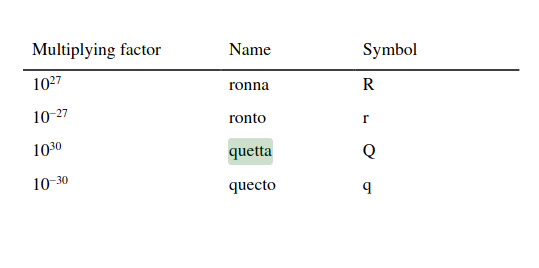

Wake up babe new SI prefixes just dropped
89 notes
·
View notes
Note
Hola Necro, espero que te encuentres bien hace rato que por cuestiones de tiempo no había podido ingresar para seguir con mis proyectos de skin jejej, pero ahora que regreso tengo una duda, si quisiera crear iconos propios para el foro y colocarlos en la skin, cual es el proceso para realizarlo, y tendrás conocimiento de que medida deben de ser los mismo. Gracias de antemano por tu apoyo.
¡Hola HR! Todo bien por acá, espero que tú también andes bien 💕
La manera más sencilla de hacer tu propia icofont es usando IcoMoon.
1.- Tendrás que buscar los svgs de los iconos que quieras usar (recomiendo FlatIcon, siempre dando crédito a los creadores). Importante que el svg del icon sea monocromo. En FlatIcon, puedes seleccionar en filtros 'Black' y usar cualquiera de las tres opciones (Outline, Fill o Hand-drawn); lo importante es que sea 'Black'. Una vez los tengas, guárdalos todos en una carpetita para que los tengas juntitos. Si los tienes ya con el nombre de la clase que quieres para ese icon, mejor que mejor.
2.- Regístrate en IcoMoon y haz click en la parte superior donde pone 'IcoMoon App'. Una vez allí, le vas a dar al hamburger icon en la parte superior izquierda y vas a darle a 'Manage Projects'. Ahí le vas a clickar a New Project, y le pones el nombre de tu fuente. Y le das a LOAD.
3.- Ahora te toca subir todos esos iconitos. Una vez subidos, te van a salir todos en la pantalla; si quieres añadir más, NO le des a upload, en 'Untitled Set', a la derecha, le das al hamburger icon y le das a 'Import to Set'. En el hamburger icon también puedes editar el nombre del set dándole a Properties -> Edit Metadata -> Name.
4.- Selecciona los iconos que finalmente llevará tu fuente. Selecciona el primer botón de arriba (el del cursor con el cuadradito) y haz click en toditos tus iconos. Ahora dale abajo a la derecha a 'Generate Font'. Antes de hacer nada, le vas a dar arriba a la izquierda a 'Preferences'. Cambia tu font name a algo único (es lo que usarías como font-family), y cambia el class prefix a algo relacionado con la font name. Puedes usar por ejemplo la referencia de cómo nombran otras fuentes de icono sus clases y nombre: phosphor/ph-, cappuccicons/cp-... Una vez que lo tengas, dale a 'CSS Selector' y selecciona 'use a class'. Usa el mismo prefijo pero sin la -. Por ejemplo, si fx- es tu prefijo, .fx es tu clase. De nuevo, ejemplos como cappuccicons: cp cp-flower-o.
5.- En esta pantalla también puedes hacer cambios generales sobre la fuente. Si no has cambiado las clases de tus iconos, edítalas aquí. Recuerda que es case-sensitive (si pones mayus, tendrás que usar mayus en tu class cuando uses el icon). También puedes modificar el código de pseudoelemento (no recomiendo cambiarlos a posteriori si updateas la fuente para añadir más iconos, o vas a tener que modificar los códigos que hagan uso de ellas).
6.- ¡Has terminado! Dale a download y sigue el método de subida de fuentes que he explicado en posts como este. IcoMoon te da el stylesheet directamente, así que solo tendrás que modificar los links en dicho CSS por los tuyos de dropbox, y luego subir ese CSS para usarlo en tu foro.
¡Espero que te haya servido este minituto! Saludines 💖
6 notes
·
View notes
Text
Round one: Shongololo vs Oiseaux
(poll at the end)
Shongololo (siSwati)
[ʃonɡolôːlo]
Translation: Millipede
siSwati is an Atlantic-Congo language belonging to the Bantu branch, which covers most of sub-Saharan Africa. It is spoken by 960 000 people in Eswatini, where it is the national language, but by 4,7 million people in total, half of whom speak it as a second language. Most of them live in South Africa. The prefix si- in siSwati indicates the noun class, shortly explained as a gender system but with more (up to 20) classes, less arbitrary categorization and different but paired classes for singular and plural. From what I’ve found, si- is the prefix for class 7, indicating body parts or pairs in siSwati. From what I remember from a lecture, some Bantu languages use the same class to signify languages, which gives related names such as isiZulu and kinyaRwanda.
Motivation: I love how it feels when saying it! It also manages to seem both long and round, just like the animal itself. <3
Note: I found evidence of shongololo being used in siSwati, but the IPA transcription is taken from Zulu (ishongololo, in which the i- signifies noun class), which is closely related to siSwati. I thought it should have the prefix in- for objects and animals but couldn’t find evidence of that word ever being used, so probably not. Someone who knows siSwati, please tell me how it all works.
Oiseaux (French)
[wa.zo]
Translation: Birds
French is an Indo-European language belonging to the Romance branch originating in France, where it has 64 million speakers and is the national language. However, due to colonialism and historical popularity in Europe (language spread due to cultural, scientific and philosophical dominance and stayed an important lingua franca), French has almost 310 million speakers worldwide, although only 80 million speak it as their first language.
Motivation: Because it has 7 letters, every vowel except for y, and it’s still somehow only two syllables and pronounced wah-zoh.
21 notes
·
View notes
Text
3 Flavors of Perfective Verbs in Three Athabascan Languages
(Sources listed at the bottom)
Athabascan languages (a sub-group of Na-Dene languages) feature verbs with many prefixes, which mark the subject, direct object, as well as adverbial elements which help the root define the action of the verb, and affixes which help identify tense and aspect, among others (as you might imagine, Athabascan verbs can get rather long). Among the Athabascan languages are Hupa, from the coastal Athabascan sub-group in Northern California, and Navajo, spoken in Arizona, Utah, and New Mexico. While both are Athabascan, they are not particularly close relatives, Hupa being in the Coastal subgroup, and Navajo being in the Southern subgroup. However, they share an interesting feature; different verbs form their perfective forms (NOT the same thing as a perfect) with one of a set of prefixes. These prefixes track to a certain nuance in sense. I will quote Pliny Earle Goddard's description of this from Hupa:
There are three simple sounds which by their presence indicate whether the act is viewed as beginnning, ending, or progressing. These sounds are not found in all forms of the same verb, but only in those tenses which refer to the act of state as one and definite.... In many cases the nature of the prefix requires the act to be thought of as beginning, ending, or progressing. The sound which is of most frequent occurrence is /w/. It stands at the beginning of a syllable, usually the one immediately preceding the root. The remainder of this syllable contains the subjective personal elements. Its initiatory force can be seen in the verbs /wiñyaʟ/ COME ON and /wiñxa/ WATER LIES like the ocean, which has no beginning... In a precisely parallel manner, /n/ occurs as the initial of the inflected syllable under circumstances which point to the completion of the act. With /wiñyaʟ/ (above) compare /niñyai/ IT ARRIVED... Without the same exact parallelism of forms which obtains with the two mentioned above, a large number of verbs have /s/ as the characteristic of the inflected syllable of the definite tenses. Most of these verbs clearly contain the idea of progression, or are used of acts which require considerable time for their accomplishment. The distributive prefix /te-/ is always followed by /s/, never by either of the other signs, and some of the prefixes listed above are used with /s/ with a distinction in meaning: for example /xawiñan/ he took a stone out of a hole (but /xaïsyai/ he came up a hill)… In one of the Eel river dialects the bringing home of a deer is narrated as follows: /yīgiñgīn/ he started carrying; /yītesgīn/ he carried along; /yīningīn/ he arrived carrying. here we have /g/ (corresponding to Hupa /w/), /s/, and /n/ used with the same stem, expressing the exact shades one would expect in Hupa.
In other words, perfectives in Hupa treat an action as either the start of a situation (with /w/), the process of a situation (with /s/) or the end of a situation (with /n/). Interestingly, there seems to be some parallel prefixes in Navajo with a similar meaning. Pulling from my notes on The Navajo Language (a book I no longer have access to, unfortunately), there are yi-, si-, and ni- perfectives in Navajo. Yi perfectives are used in the simple completion of the action of the verb, si-perfectives are used when the action creates a stative or durative state (for example “I set it up”), and ni-perfectives are terminal in effect, such as in arriving, stopping, finishing, etc. These prefixes also appear in some Navajo imperfective forms as well, adding the simple, final, or setting-up nuance to an imperfective action. These similarities, especially in the Hupa /s/ and /n/ with the Navajo /si/ and /ni/, show an interesting commonality.
Before I finish, I just remembered that I have another resource on an Athabascan language, namely of Mattole, another coastal Athabascan language. I have yet to devote much time to Mattole, and this document is a fairly brief overview, but it also describes the many prefixes of Mattole, and among the classes of prefixes are these (emphasis mine):
Time-aspect prefixes These express whether the action or situation lasts on (si), is going on all the time or is concerned with the result (ɣi), is instantaneous (ni), occurs in the future (diɣi), or involves a permission (oo).
Again, we see a difference in meaning, but there is noticeable overlap
Sources:
The Navajo Language: A Grammar and Colloquial Dictionary - Robert Young, William Morgan; 1987
Hupa - Entry in the Handbook of American Indian Languages, Pliny Earle Goddard; 1911
A Survey of the Athabaskan Language Mattole - Dick Grune; 2015
14 notes
·
View notes
Text
Had someone argue in class today that the prefixes of the SI units couldn't be used on grams because we already used them on meters.
#my adventures in chemistry#my professor was so patient in explaining what prefixes where#even though it wasn't english class
12 notes
·
View notes